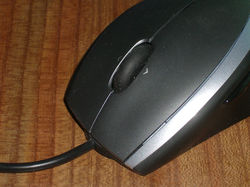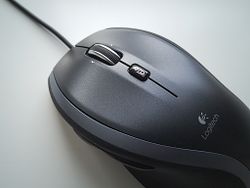Scroll wheel
| This article requires photographic illustration — need more and better photos |
A scroll wheel is a vertically-oriented, typically rubber-coated wheel that sits between the left and right buttons of a mouse. Similar functionality exists on some trackballs as well.
Scroll wheels are typically about 1 inch in diameter and 8 mm thick.
Functionality
Scrolling
Rotating the wheel sends vertical scroll commands in many graphical desktop systems. In many systems, the panel or control under the cursor is scrolled; in Microsoft Windows, however, it's far more common for the scroll events to be sent to whichever control has the focus. This behaviour can be modified through many programs.
Most wheels have tactile detents (notches), each corresponding to a scrolling step. There are typically 24 detents per revolution, but some wheels have only 18. When a electromechanical rotary encoder is used, the detents tend to be a property of it. When an optoelectric encoder is used instead, the detents are created by a separate spring.
In Microsoft Windows, each step is a fixed amount of three lines of text. Faster rotation of the wheel in some systems, including in Apple's macOS, increases the scroll distance per step to provide accelerated scrolling. Scrolling acceleration is also provided as a feature in the Microsoft IntelliPoint driver software supplied with the IntelliMouse.
Smooth scrolling
In Windows Vista, Microsoft introduced a protocol on top of USB HID for smoother scrolling with higher resolution than per detent.
When a mouse powers up it should not do smooth scrolling by default but when Windows boots it would tell the mouse to increase its resolution.[1]
However, some of Microsoft's own mice suffer from a bug that it does not reset its internal resolution when the host reboots. This has the effect that when users dual-boots from Windows into an operating system that does not support the protocol, scrolling is much too fast. Workarounds includes power-cycling the mouse (re-plugging) and to run a specific utility which sends the mouse the appropriate message.[2]
Mouse button three
Most scroll wheels work as mouse button three when pressed straight down. The button is often heavier than other buttons.
PC mice before scroll wheels traditionally followed two competing standards: Logitech's and Microsoft's. Logitech favoured three-button mice, and Microsoft favoured two. First with Microsoft's first scroll wheel-equipped IntelliMouse, did they make the transition of three-button mice, but putting it under the wheel.
This non-obvious functionality, together with traditionally limited adoption by Windows and software applications, has lead to a general lack of awareness of this additional button. The number of websites that fail to accept middle-click to open links in a new tab suggests how many web designers alone remain oblivious to this facility.
Variations
Dual axis scrolling
Dual scroll wheels
A few mice featured dual scroll wheels, one per axis. These could be arranged parallel or perpendicular to each other. This design is quite rare, and dual-axis scrolling now is typically achieved using a tilt wheel.
Tilt wheel
A tilt wheel is a scroll wheel than can be leaned sideways to achieve sideways scrolling. This tends to come at the cost of reliable middle button action.
Free motion wheel
The mouse wheel typically moves in precise steps defined by mechanical detents. These wheel notches allow for precise scrolling.
Some wheels, such as that of the Microsoft Comfort Mouse 4500, rotate freely without detents slowing it down. Scrolling through a document slowly requires particular practice.
Some mice can switch between having detents and free motion. On some mice there is a latching button next to the wheel (or inconveniently under the mouse) which switches between the two modes. On some other mice the button is in the scroll wheel instead of a third mouse button.
A speed-adaptive scroll wheel deactivates detents automatically when the wheel is spun fast enough.
Alternatives
Scroll ball

Omega's 3D Magic Optical Scrolling Mouse[3] and Apple A1152 have each instead of a wheel, a small trackball that allows two-dimensional scrolling.
Scroll toggle
Some pointing devices have a special button that while held turns the device into a scrolling device.
In xorg, an implementation of the X Window System (the de-factor standard under Linux and most Unix systems), any button can be turned into such a toggle. Open (or create) the file /etc/X11/xorg.conf.d/10-evdev.conf and add the following section:
Section "InputClass" Identifier "Mouse0" Driver "evdev" MatchIsPointer "on" MatchDevicePath "/dev/input/event*" Option "EmulateWheel" "true" Option "EmulateWheelButton" "9" Option "ZAxisMapping" "4 5" Option "XAxisMapping" "6 7" EndSection
The example above makes the button #9 (usually the forward button) into a scrolling-toggle button.
Scrolling stick
IBM's TrackPoint Mouse series had an analogue TrackPoint for scrolling in two dimensions. Later Scrollpoint models (also Lenovo) had a larger analogue joystick more shaped like a mouse button.
Researchers at IBM have done user testing that showed the scrolling stick to be both faster and more preferred by their test users over the scroll wheel[4]. It does however require a driver or tweaked settings to reduce sensitivity, or the stick will scroll too fast for normal use.
Rocker switch
Genius NetMouse series have a flat rocker-button in-between left and right mouse buttons that can be pressed forward or back.[5].
Genius NewScroll and Mitsumi Scroll Mouse have a smaller knob that can be rocked forwards and backwards instead of a flat button, but work the same way.[6] Unlike a TrackPoint/ScrollPoint these are digital and scroll only vertically.
Scroll ring
Some of the trackballs from Kensington have a rotating ring around the trackball for scrolling. It was introduced with the Kensington TurboRing (2000) and then later in the Kensington Expert Mouse in 2003.[7]
Touch surface
There are now many mice that use a touch-sensitive surface instead of scrollwheel.
Some use a wide touch surface for horizontal swipes and even taps for such actions as "Back" and "Forward". In such designs the touch-surface could interfere with the action of the mouse buttons. On Apple's Magic Mouse the whole touch surface is titled to click, with left and right mouse buttons distinguished only by which area of the surface that has a finger. This does not allow a finger to be resting on the left button while the right button is clicked.
History
The scroll wheel on a mouse has been invented multiple times by different people unaware of each-other's work. Other scrolling controls on a mouse, and the use of a spinner for scrolling both precede the combination of wheel-on-mouse. The earliest known wheel shown to the public was a research project from Apple at a conference in 1989[8] followed by a patent, applied for in 1992.
The first mouse with scroll wheel available on the market was the Mouse Systems ProAgio Scroll Mouse from in 1995. It was also sold as the Genius EasyScroll. [9]
Microsoft popularised the scroll wheel with the IntelliMouse in 1996.
IBM's TrackPoint Mouse was the first commercial mouse with two-dimensional scrolling.[8]
References
- ↑ Microsoft - Wheel Support in Windows. Dated 2010-11-10. Retrieved 2016-04-06.
- ↑ Ubuntu Answers - Change scroll wheel speed.Retrieved 2016-10-30.
- ↑ Microsoft Research, Buxton Collection—4D Magic Optical Scrolling Mouse. Retrieved 2019-02-09
- ↑ Shumin Zhai, Barton A. Smith, Ted Selker Dual Stream Input for Pointing and Scrolling. Proceedings of the ACM CHI 97 Human Factors in Computing Systems Conference
- ↑ The Collection of Calculating Devices—Genius NetMouse. Retrieved 2021-03-14
- ↑ iXBT Labs—Mouses: testing 13 models. Retrieved 2021-03-15
- ↑ Interesting Thing of the Day—The Evolution of Scrolling] by Joe Kissel. Dated 2004-10-07. Retrieved 2018-12-04
- ↑ 8.0 8.1 BillBuxton.com—Some Milestones in Computer Input Devices: An Informal Timeline. Revision dated 2018-11-23, retrieved 2018-12-04
- ↑ Oldmouse.com—Mouse Systems ProAgio Scroll Mouse. Retrieved 2018-12-04


